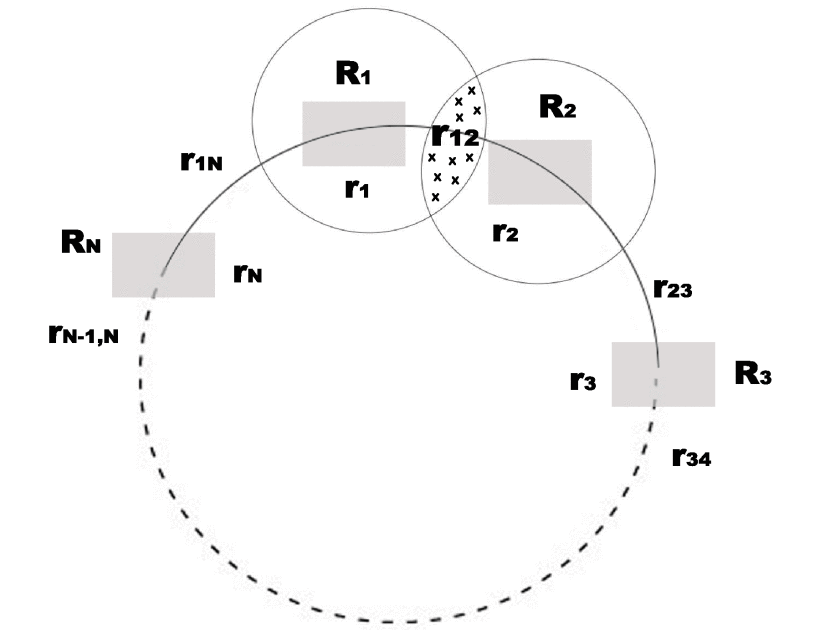Breadcrumb
Towards Mobility-Aware Proactive Caching for Vehicular Ad hoc Networks
Harnessing information about the user mobility pattern and daily demand can enhance the network capability to improve the quality of experience (QoE) at Vehicular Ad- Hoc Networks (VANETs). Proactive caching, as one of the key features offered by 5G networks, has lately received much interest. However, more research is still needed to convey large-sized multimedia content including video, audio and pictures to the high speed moving vehicles. In this paper, we study the gains achieved by proactive caching in Roadside Units (RSUs) where we take into consideration the effect of the vehicle
Improved spectrum mobility using virtual reservation in collaborative cognitive radio networks
Cognitive radio technology would enable a set of secondary users (SU) to opportunistically use the spectrum licensed to a primary user (PU). On the appearance of this PU on a specific frequency band, any SU occupying this band should free it for PUs. Typically, SUs may collaborate to reduce the impact of cognitive users on the primary network and to improve the performance of the SUs. In this paper, we propose and analyze the performance of virtual reservation in collaborative cognitive networks. Virtual reservation is a novel link maintenance strategy that aims to maximize the throughput of
Towards optimal power control for delay-constrained cognitive radio networks
In this paper we study the problem of optimal power control for a Z-interference channel abstracting an underlay cognitive radio network where the secondary user has delay constraints. More specifically, we minimize the packet drop probability at the secondary user (equivalent to delay bound violation probability) subject to quality of service (QoS) constraints at the primary and secondary users, among other constraints. Towards, this objective, we develop a mathematical framework using Markov chains and formulate a constrained optimization problem. First, we assess the complexity of the
Reduced-complexity SFBC-OFDM for vehicular channels with high mobility
Space frequency block coding with orthogonal frequency division multiplexing (SFBC-OFDM) suffers from the effect of inter-carrier interference (ICI) in doubly-selective communication channels. In this paper, a scheme is proposed in which windowing is applied to the received signal to reduce the effect of ICI to a limited number of neighboring sub-carriers. The sub-carriers holding the SFBC components of each codeword are separated by a number of sub-carriers larger than the ICI range, and hence, they do not interfere with each other. In order to preserve the structure of the SFBC, the
ARQ security in Wi-Fi and RFID networks
In this paper, we present two practical ARQ-Based security schemes for Wi-Fi and RFID networks. Our proposed schemes enhance the confidentiality and authenticity functions of these networks, respectively. Both schemes build on the same idea; by exploiting the statistical independence between the multipath fading experienced by the legitimate nodes and potential adversaries, secret keys are established and then are continuously updated. The continuous key update property of both schemes makes them capable of defending against all of the passive eavesdropping attacks and most of the currently
ARQ secrecy over correlated fading channels
In this paper, we develop novel Automatic Repeat reQuest (ARQ) key sharing protocols for correlated fading channels. In particular, a novel role of "dumb antennas" in overcoming the negative impact of spatial correlation, on the achievable secrecy rates , is unveiled. We further develop an adaptive rate allocation policy which achieves higher secrecy rates by exploiting the channel temporal correlation. The performance gains offered by the proposed schemes are demonstrated by a comprehensive set of numerical results.
ARQ secrecy: From theory to practice
Inspired by our earlier work on Automatic Repeat reQuest (ARQ) secrecy, we propose a simple, yet efficient, security overlay protocol to existing 802.11 networks. Our work targets networks secured by theWired Equivalent Privacy (WEP) protocol because of its widespread use and vulnerability to a multitude of security threats. By exploiting the existing ARQ protocol in the 802.11 standard, our proposed opportunistic secrecy scheme is shown to defend against all known passive WEP attacks. Moreover, our implementation on the madwifi-ng driver is used to establish the achievability of a vanishing
Asymmetrical clipping optical filter bank multi-carrier modulation scheme
Authentication over noisy channels
An authentication counterpart of Wyner's study of the wiretap channel is developed in this work. More specifically, message authentication over noisy channels is studied while impersonation and substitution attacks are investigated for both single- and multiple-message scenarios. For each scenario, information-theoretic lower and upper bounds on the opponent's success, or cheating, probability are derived. Remarkably, in both scenarios, the lower and upper bounds are shown to match, and hence, the fundamental limits on message authentication over noisy channels are fully characterized. The

Towards Extended Bit Tracking for Scalable and Robust RFID Tag Identification Systems
The surge in demand for Internet of Things (IoT) systems and applications has motivated a paradigm shift in the development of viable radio frequency identification technology (RFID)-based solutions for ubiquitous real-Time monitoring and tracking. Bit tracking-based anti-collision algorithms have attracted considerable attention, recently, due to its positive impact on decreasing the identification time. We aim to extend bit tracking to work effectively over erroneous channels and scalable multi RFID readers systems. Towards this objective, we extend the bit tracking technique along two
Pagination
- Previous page ‹‹
- Page 4
- Next page ››
